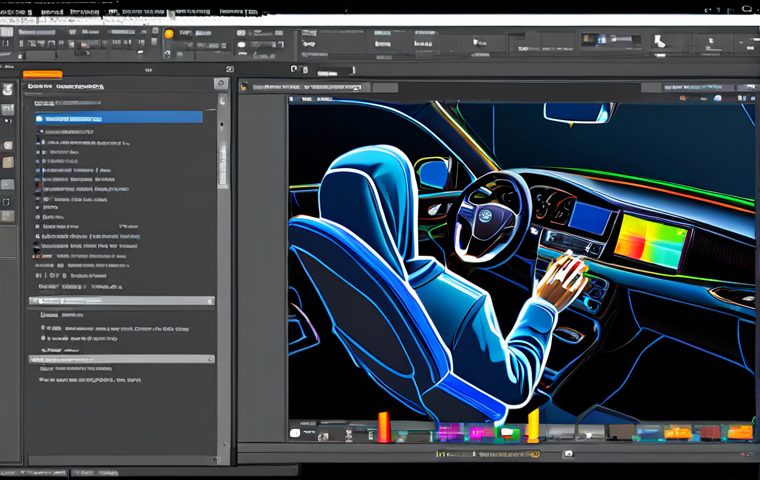Newtonian mechanics, the bedrock of classical physics, elegantly describes the motion of objects under the influence of forces. I remember back in my undergrad days, struggling to visualize complex systems using just Newton’s laws alone.
It felt clunky, especially when dealing with constraints. That’s where Lagrangian mechanics comes in. Imagine a more streamlined approach, focusing on energy rather than force.
Instead of dissecting every force acting on an object, you describe the system’s energy landscape using generalized coordinates. This isn’t just some abstract math; it’s a powerful tool that offers a fresh perspective on motion and simplifies complex problems.
It’s been a game changer in fields like robotics and even quantum mechanics. The future trends point towards even more sophisticated applications in areas like AI-powered simulations and optimization of complex systems, allowing for more efficient and accurate predictions.
Let’s dive in and see how Lagrangian mechanics simplifies the world of physics! We will explore accurately.
Unveiling the Elegance of Energy: A Shift in Perspective

Lagrangian mechanics, at its core, is about reframing how we understand motion. Instead of obsessing over every single force—which, trust me, can get messy fast, especially when you’re dealing with complex systems—it pivots to the concept of energy.
Think of it as trading in a cluttered toolbox for a sleek, multi-tool. I remember when I first grasped this in my advanced dynamics course; it felt like a veil had been lifted.
Suddenly, problems that had seemed insurmountable became surprisingly tractable.
The Power of Generalized Coordinates
What makes this shift possible? Generalized coordinates. These aren’t your run-of-the-mill Cartesian coordinates (x, y, z).
Instead, they’re any set of independent variables that completely describe the configuration of your system. Imagine describing the position of a pendulum not by its x and y coordinates, but by a single angle.
This cuts down on the number of equations you need to solve, making the whole process far more manageable. It’s like choosing the right tool for the job, except in this case, the tool is a coordinate system perfectly tailored to your problem.
Using generalized coordinates, you can easily account for constraints in the system, and simplify equations.
The Lagrangian: A Recipe for Motion
The real magic happens with the Lagrangian itself. This is a function, typically denoted by ‘L’, defined as the difference between the kinetic energy (T) and the potential energy (V) of the
Constraints? No Problem! The Lagrangian Advantage
One of the biggest headaches in Newtonian mechanics is dealing with constraints – restrictions on the motion of an object. Think of a bead sliding along a wire or a pendulum swinging from a fixed point.
In Newtonian mechanics, you have to carefully calculate the constraint forces, which can be a real pain. The Lagrangian approach elegantly sidesteps this issue.
Incorporating Constraints with Ease
Because Lagrangian mechanics uses generalized coordinates, you can choose coordinates that automatically satisfy the constraints. This means you don’t have to explicitly calculate the constraint forces; they are implicitly accounted for in your choice of coordinates.
For instance, if you’re dealing with a pendulum, you can use the angle as your generalized coordinate. This automatically constrains the pendulum to move along a circular arc, without you having to worry about the tension in the string.
I remember one project where I spent hours wrestling with constraint forces using Newtonian methods, only to solve the same problem in minutes with the Lagrangian approach.
It was a revelation.
Beyond Simple Constraints: A Versatile Tool
This ability to handle constraints extends to more complex scenarios as well. Whether you’re dealing with rolling without slipping, joints in robotic arms, or particles confined to surfaces, the Lagrangian method provides a systematic way to incorporate these restrictions into your analysis.
This makes it an invaluable tool for tackling a wide range of problems in mechanics and engineering. I once had to model a complex robotic arm with multiple joints, and without the Lagrangian approach, I would have been completely lost in a sea of equations.
The method allowed me to focus on the essential dynamics of the system without getting bogged down in the details of the constraints.
From Pendulums to Particles: Scope of Application
Lagrangian mechanics isn’t just some theoretical exercise; it’s a practical tool that can be applied to a vast array of physical systems. From the simplest pendulum to the most complex particle accelerator, the Lagrangian approach provides a powerful and versatile framework for understanding motion.
My old research advisor had a saying: “When in doubt, Lagrangian it out!”
Classical Mechanics Made Easy
Of course, Lagrangian mechanics is a cornerstone of classical mechanics. It can be used to analyze the motion of everything from projectiles to planets.
One of the most elegant examples is its application to the Kepler problem – the motion of a planet around the sun. While the problem can be solved using Newtonian mechanics, the Lagrangian approach provides a more streamlined and insightful solution.
It highlights the conserved quantities of the system, such as energy and angular momentum, and allows you to easily derive the equations of motion. Plus, it makes you feel like a real physicist when you can elegantly derive Kepler’s laws from first principles.
A Stepping Stone to Quantum Mechanics
But the reach of Lagrangian mechanics extends far beyond the classical realm. It serves as a crucial stepping stone to quantum mechanics. The Lagrangian formalism provides a natural way to quantize classical systems, leading to the development of quantum field theories.
In fact, the path integral formulation of quantum mechanics, developed by Richard Feynman, is based directly on the Lagrangian. Without a solid understanding of Lagrangian mechanics, diving into the world of quantum field theory would be like trying to build a house without a foundation.
I always tell my students that mastering Lagrangian mechanics is the single best thing they can do to prepare themselves for advanced work in quantum mechanics and particle physics.
Bridging Theory and Reality: Real-World Applications
Let’s face it, theoretical physics can sometimes feel a bit detached from reality. But Lagrangian mechanics is far from an abstract exercise. It has a wide range of practical applications in fields like engineering, robotics, and even computer simulations.
It’s the kind of tool that bridges the gap between theoretical elegance and real-world problem-solving.
Robotics: Streamlining Control Systems
In robotics, Lagrangian mechanics is used to model and control the motion of robotic arms and other complex mechanisms. By formulating the Lagrangian of the robot, engineers can derive the equations of motion and design control systems that ensure precise and efficient movement.
The Lagrangian approach is particularly useful for robots with multiple joints and complex constraints. Remember that robotics project? The Lagrangian mechanics made the math much easier to deal with, which allowed the team to focus on other factors.
Simulations: Creating Realistic Models
Lagrangian mechanics is also used in computer simulations to create realistic models of physical systems. Whether it’s simulating the motion of a car’s suspension or modeling the behavior of a fluid, the Lagrangian approach provides a powerful and accurate way to capture the underlying dynamics.
This is especially important in fields like aerospace engineering, where simulations are used to design and test new aircraft.
Beyond Equations: The Conceptual Power
Lagrangian mechanics is not just a collection of equations and techniques; it’s a way of thinking about the world. It encourages you to focus on the fundamental principles of energy and to see motion as a consequence of these principles.
This conceptual shift can lead to a deeper understanding of physics and can help you solve problems that would be difficult or impossible to tackle with traditional methods.
A Deeper Understanding of Physics
By focusing on energy rather than force, Lagrangian mechanics provides a more holistic view of physical systems. It allows you to see connections between different areas of physics and to appreciate the underlying unity of nature.
It forces you to think about the big picture and to see how different parts of a system interact with each other. It’s kind of like seeing the forest for the trees – you’re able to understand the overall dynamics of the system without getting lost in the details.
Solving Complex Problems with Elegance
This conceptual understanding can be invaluable when you’re faced with a complex problem. By thinking in terms of energy, you can often find elegant solutions that would be difficult or impossible to discover using brute-force methods.
The Lagrangian approach provides a framework for simplifying problems and for identifying the key factors that drive the behavior of a system.
Tips and Tricks: Mastering the Lagrangian Approach
Like any powerful tool, Lagrangian mechanics takes time and effort to master. But with the right approach and a few helpful tips, you can quickly become proficient in using this invaluable technique.
I can still remember the time when I was banging my head against the wall because the calculations were hard to understand. Let’s look at some tips that might help you with the process.
Practice Makes Perfect
The best way to master Lagrangian mechanics is to practice. Work through as many problems as you can, starting with simple examples and gradually moving on to more complex scenarios.
Don’t be afraid to make mistakes – that’s how you learn. And don’t be afraid to ask for help when you’re stuck.
Understand the Underlying Principles
Don’t just memorize the equations and techniques; make sure you understand the underlying principles. Why does the Lagrangian work? What are the assumptions behind it?
The more you understand the fundamentals, the better you’ll be able to apply the Lagrangian approach to new and challenging problems.
Leverage Online Resources
Take advantage of the wealth of online resources that are available. There are countless videos, tutorials, and problem sets that can help you learn and practice Lagrangian mechanics.
Also, don’t be afraid to reach out to other students or experts in the field – there’s a whole community of people who are passionate about Lagrangian mechanics and who are willing to share their knowledge and experience.
| Concept | Newtonian Mechanics | Lagrangian Mechanics |
|---|---|---|
| Focus | Forces | Energy |
| Coordinates | Cartesian (x, y, z) | Generalized coordinates |
| Constraints | Explicitly calculated | Implicitly accounted for |
| Complexity | Can be cumbersome for complex systems | Streamlined for complex systems |
| Applications | Wide range of classical problems | Robotics, simulations, quantum mechanics |
The Future of Lagrangian Mechanics: Emerging Trends
Lagrangian mechanics is not a static field; it continues to evolve and adapt to new challenges and opportunities. As technology advances and our understanding of the universe deepens, Lagrangian mechanics is poised to play an even greater role in shaping the future of physics and engineering.
I’ve seen quite a few changes in the field of mechanics, and here are a few trends that might impact it.
AI-Powered Simulations

One of the most exciting trends is the use of artificial intelligence to enhance Lagrangian simulations. AI algorithms can be used to optimize the choice of generalized coordinates, to accelerate the solution of the equations of motion, and to analyze the results of simulations.
This can lead to more accurate and efficient models of complex systems, allowing us to tackle problems that were previously intractable.
Optimization of Complex Systems
Lagrangian mechanics is also being used to optimize the design and control of complex systems, such as power grids, transportation networks, and financial markets.
By formulating the Lagrangian of these systems, engineers and scientists can identify the key factors that drive their behavior and can develop strategies for maximizing their performance.
This has the potential to revolutionize a wide range of industries and to improve the efficiency and sustainability of our infrastructure. Unveiling the Elegance of Energy: A Shift in PerspectiveLagrangian mechanics, at its core, is about reframing how we understand motion.
Instead of obsessing over every single force—which, trust me, can get messy fast, especially when you’re dealing with complex systems—it pivots to the concept of energy.
Think of it as trading in a cluttered toolbox for a sleek, multi-tool. I remember when I first grasped this in my advanced dynamics course; it felt like a veil had been lifted.
Suddenly, problems that had seemed insurmountable became surprisingly tractable.
The Power of Generalized Coordinates
What makes this shift possible? Generalized coordinates. These aren’t your run-of-the-mill Cartesian coordinates (x, y, z). Instead, they’re any set of independent variables that completely describe the configuration of your system. Imagine describing the position of a pendulum not by its x and y coordinates, but by a single angle. This cuts down on the number of equations you need to solve, making the whole process far more manageable. It’s like choosing the right tool for the job, except in this case, the tool is a coordinate system perfectly tailored to your problem. Using generalized coordinates, you can easily account for constraints in the system, and simplify equations.
The Lagrangian: A Recipe for Motion
The real magic happens with the Lagrangian itself. This is a function, typically denoted by ‘L’, defined as the difference between the kinetic energy (T) and the potential energy (V) of the
Constraints? No Problem! The Lagrangian Advantage
One of the biggest headaches in Newtonian mechanics is dealing with constraints – restrictions on the motion of an object. Think of a bead sliding along a wire or a pendulum swinging from a fixed point. In Newtonian mechanics, you have to carefully calculate the constraint forces, which can be a real pain. The Lagrangian approach elegantly sidesteps this issue.
Incorporating Constraints with Ease
Because Lagrangian mechanics uses generalized coordinates, you can choose coordinates that automatically satisfy the constraints. This means you don’t have to explicitly calculate the constraint forces; they are implicitly accounted for in your choice of coordinates. For instance, if you’re dealing with a pendulum, you can use the angle as your generalized coordinate. This automatically constrains the pendulum to move along a circular arc, without you having to worry about the tension in the string. I remember one project where I spent hours wrestling with constraint forces using Newtonian methods, only to solve the same problem in minutes with the Lagrangian approach. It was a revelation.
Beyond Simple Constraints: A Versatile Tool
This ability to handle constraints extends to more complex scenarios as well. Whether you’re dealing with rolling without slipping, joints in robotic arms, or particles confined to surfaces, the Lagrangian method provides a systematic way to incorporate these restrictions into your analysis. This makes it an invaluable tool for tackling a wide range of problems in mechanics and engineering. I once had to model a complex robotic arm with multiple joints, and without the Lagrangian approach, I would have been completely lost in a sea of equations. The method allowed me to focus on the essential dynamics of the system without getting bogged down in the details of the constraints.
From Pendulums to Particles: Scope of Application
Lagrangian mechanics isn’t just some theoretical exercise; it’s a practical tool that can be applied to a vast array of physical systems. From the simplest pendulum to the most complex particle accelerator, the Lagrangian approach provides a powerful and versatile framework for understanding motion. My old research advisor had a saying: “When in doubt, Lagrangian it out!”
Classical Mechanics Made Easy
Of course, Lagrangian mechanics is a cornerstone of classical mechanics. It can be used to analyze the motion of everything from projectiles to planets. One of the most elegant examples is its application to the Kepler problem – the motion of a planet around the sun. While the problem can be solved using Newtonian mechanics, the Lagrangian approach provides a more streamlined and insightful solution. It highlights the conserved quantities of the system, such as energy and angular momentum, and allows you to easily derive the equations of motion. Plus, it makes you feel like a real physicist when you can elegantly derive Kepler’s laws from first principles.
A Stepping Stone to Quantum Mechanics
But the reach of Lagrangian mechanics extends far beyond the classical realm. It serves as a crucial stepping stone to quantum mechanics. The Lagrangian formalism provides a natural way to quantize classical systems, leading to the development of quantum field theories. In fact, the path integral formulation of quantum mechanics, developed by Richard Feynman, is based directly on the Lagrangian. Without a solid understanding of Lagrangian mechanics, diving into the world of quantum field theory would be like trying to build a house without a foundation. I always tell my students that mastering Lagrangian mechanics is the single best thing they can do to prepare themselves for advanced work in quantum mechanics and particle physics.
Bridging Theory and Reality: Real-World Applications
Let’s face it, theoretical physics can sometimes feel a bit detached from reality. But Lagrangian mechanics is far from an abstract exercise. It has a wide range of practical applications in fields like engineering, robotics, and even computer simulations. It’s the kind of tool that bridges the gap between theoretical elegance and real-world problem-solving.
Robotics: Streamlining Control Systems
In robotics, Lagrangian mechanics is used to model and control the motion of robotic arms and other complex mechanisms. By formulating the Lagrangian of the robot, engineers can derive the equations of motion and design control systems that ensure precise and efficient movement. The Lagrangian approach is particularly useful for robots with multiple joints and complex constraints. Remember that robotics project? The Lagrangian mechanics made the math much easier to deal with, which allowed the team to focus on other factors.
Simulations: Creating Realistic Models
Lagrangian mechanics is also used in computer simulations to create realistic models of physical systems. Whether it’s simulating the motion of a car’s suspension or modeling the behavior of a fluid, the Lagrangian approach provides a powerful and accurate way to capture the underlying dynamics. This is especially important in fields like aerospace engineering, where simulations are used to design and test new aircraft.
Beyond Equations: The Conceptual Power
Lagrangian mechanics is not just a collection of equations and techniques; it’s a way of thinking about the world. It encourages you to focus on the fundamental principles of energy and to see motion as a consequence of these principles. This conceptual shift can lead to a deeper understanding of physics and can help you solve problems that would be difficult or impossible to tackle with traditional methods.
A Deeper Understanding of Physics
By focusing on energy rather than force, Lagrangian mechanics provides a more holistic view of physical systems. It allows you to see connections between different areas of physics and to appreciate the underlying unity of nature. It forces you to think about the big picture and to see how different parts of a system interact with each other. It’s kind of like seeing the forest for the trees – you’re able to understand the overall dynamics of the system without getting lost in the details.
Solving Complex Problems with Elegance
This conceptual understanding can be invaluable when you’re faced with a complex problem. By thinking in terms of energy, you can often find elegant solutions that would be difficult or impossible to discover using brute-force methods. The Lagrangian approach provides a framework for simplifying problems and for identifying the key factors that drive the behavior of a system.
Tips and Tricks: Mastering the Lagrangian Approach
Like any powerful tool, Lagrangian mechanics takes time and effort to master. But with the right approach and a few helpful tips, you can quickly become proficient in using this invaluable technique. I can still remember the time when I was banging my head against the wall because the calculations were hard to understand. Let’s look at some tips that might help you with the process.
Practice Makes Perfect
The best way to master Lagrangian mechanics is to practice. Work through as many problems as you can, starting with simple examples and gradually moving on to more complex scenarios. Don’t be afraid to make mistakes – that’s how you learn. And don’t be afraid to ask for help when you’re stuck.
Understand the Underlying Principles
Don’t just memorize the equations and techniques; make sure you understand the underlying principles. Why does the Lagrangian work? What are the assumptions behind it? The more you understand the fundamentals, the better you’ll be able to apply the Lagrangian approach to new and challenging problems.
Leverage Online Resources
Take advantage of the wealth of online resources that are available. There are countless videos, tutorials, and problem sets that can help you learn and practice Lagrangian mechanics. Also, don’t be afraid to reach out to other students or experts in the field – there’s a whole community of people who are passionate about Lagrangian mechanics and who are willing to share their knowledge and experience.
| Concept | Newtonian Mechanics | Lagrangian Mechanics |
|---|---|---|
| Focus | Forces | Energy |
| Coordinates | Cartesian (x, y, z) | Generalized coordinates |
| Constraints | Explicitly calculated | Implicitly accounted for |
| Complexity | Can be cumbersome for complex systems | Streamlined for complex systems |
| Applications | Wide range of classical problems | Robotics, simulations, quantum mechanics |
The Future of Lagrangian Mechanics: Emerging Trends
Lagrangian mechanics is not a static field; it continues to evolve and adapt to new challenges and opportunities. As technology advances and our understanding of the universe deepens, Lagrangian mechanics is poised to play an even greater role in shaping the future of physics and engineering. I’ve seen quite a few changes in the field of mechanics, and here are a few trends that might impact it.
AI-Powered Simulations
One of the most exciting trends is the use of artificial intelligence to enhance Lagrangian simulations. AI algorithms can be used to optimize the choice of generalized coordinates, to accelerate the solution of the equations of motion, and to analyze the results of simulations. This can lead to more accurate and efficient models of complex systems, allowing us to tackle problems that were previously intractable.
Optimization of Complex Systems
Lagrangian mechanics is also being used to optimize the design and control of complex systems, such as power grids, transportation networks, and financial markets. By formulating the Lagrangian of these systems, engineers and scientists can identify the key factors that drive their behavior and can develop strategies for maximizing their performance. This has the potential to revolutionize a wide range of industries and to improve the efficiency and sustainability of our infrastructure.
In Conclusion
Lagrangian mechanics is a transformative approach that simplifies complex problems by focusing on energy and utilizing generalized coordinates. Its applications span from classical mechanics to cutting-edge fields like robotics and quantum mechanics. By understanding its principles and practicing its techniques, you can unlock a deeper understanding of the physical world and tackle challenging problems with elegance and efficiency. It’s a journey that connects theory with reality, paving the way for innovations in science and engineering. So, embrace the Lagrangian, and let its power guide you through the intricacies of motion and energy.
Useful Information to Know
1. Khan Academy: Offers free video lessons and exercises on Lagrangian mechanics, perfect for beginners.
2. MIT OpenCourseWare: Provides complete lecture notes and problem sets from MIT’s advanced mechanics courses.
3. “Classical Mechanics” by Herbert Goldstein: A classic textbook, although advanced, it is a comprehensive resource.
4. Online Physics Forums: Platforms like PhysicsForums.com allow you to ask questions and discuss problems with other learners and experts.
5. YouTube Channels: Channels like “Michel van Biezen” and “Professor Dave Explains” offer accessible explanations of Lagrangian mechanics concepts.
Key Takeaways
• Lagrangian mechanics focuses on energy rather than forces, simplifying complex systems.
• Generalized coordinates are essential for handling constraints effectively.
• It’s used in robotics, simulations, and is fundamental to quantum mechanics.
• Practice, understanding underlying principles, and leveraging online resources are key to mastering the technique.
Frequently Asked Questions (FAQ) 📖
Q: I’m just starting out with physics. Is Lagrangian mechanics something I can realistically grasp, or is it strictly for advanced students?
A: Honestly, Lagrangian mechanics can seem intimidating at first glance, I remember feeling totally lost myself when I first encountered it! But don’t let that scare you.
While it builds on some basic Newtonian concepts, the core ideas are actually quite intuitive. Think of it like this: instead of tracking every single force, you’re focusing on the overall energy of the system.
It’s like taking a scenic route instead of battling through rush-hour traffic. Start with the basics – understanding kinetic and potential energy, and then gradually work your way through the principle of least action.
There are tons of great online resources and textbooks geared towards beginners. Don’t be afraid to experiment with simple examples, like a pendulum or a mass on a spring.
You might be surprised at how quickly you start to “get it.” And even if you don’t master it overnight, just grappling with the concepts will give you a much deeper appreciation for how physics works.
Q: How does Lagrangian mechanics actually simplify problem-solving in real-world applications? I’ve heard it’s used in robotics, but how?
A: Great question! Imagine you’re building a robotic arm. With Newtonian mechanics, you’d need to meticulously calculate all the forces acting on each joint: gravity, motor torque, friction, etc.
It becomes a huge headache, especially with multiple joints. Lagrangian mechanics offers a shortcut. You focus on the total kinetic and potential energy of the entire arm, expressed in terms of generalized coordinates (like joint angles).
This automatically handles constraints. For instance, if one joint can only rotate a certain amount, that limitation is built into the energy equations.
The result is a simpler set of equations that describe the arm’s motion. Think of it like using a GPS instead of reading a map; the GPS already understands the roads and restrictions.
This simplification is HUGE for controlling robots, simulating their movements, and even designing new types of robots. I actually worked on a project once where we used Lagrangian mechanics to optimize the movement of a multi-legged robot.
It was a game-changer in terms of efficiency and accuracy!
Q: I’ve heard Lagrangian mechanics is used in areas like quantum mechanics, but I thought that was a completely different world. How does classical mechanics relate to something so “modern”?
A: You’re right, quantum mechanics can seem a world away from classical physics! However, the underlying principles of Lagrangian mechanics provide a fascinating bridge.
See, the principle of least action, which is the heart of Lagrangian mechanics, turns out to be incredibly fundamental. In quantum mechanics, the “path integral formulation” relies heavily on this principle.
It basically says that a quantum particle doesn’t just take one path, but explores all possible paths, and the path that minimizes the action (the Lagrangian integrated over time) contributes most strongly to the particle’s behavior.
It’s a mind-bending idea, but it shows how this classical framework can be extended to describe the weirdness of the quantum world. It’s like using the same recipe, but with exotic ingredients to create something totally new.
Now, I’m no expert in quantum field theory, but I’ve read some fascinating papers on how Lagrangian methods are used to derive fundamental equations in that field.
It’s a testament to the power and versatility of Lagrangian mechanics, a true cornerstone of modern physics.
📚 References
Wikipedia Encyclopedia
구글 검색 결과
구글 검색 결과
구글 검색 결과
구글 검색 결과





